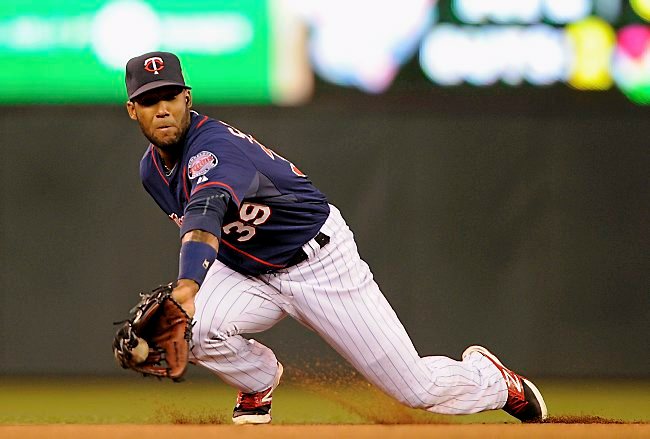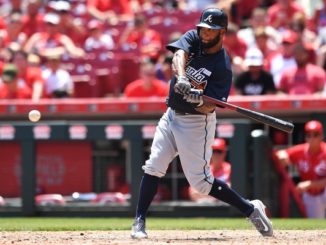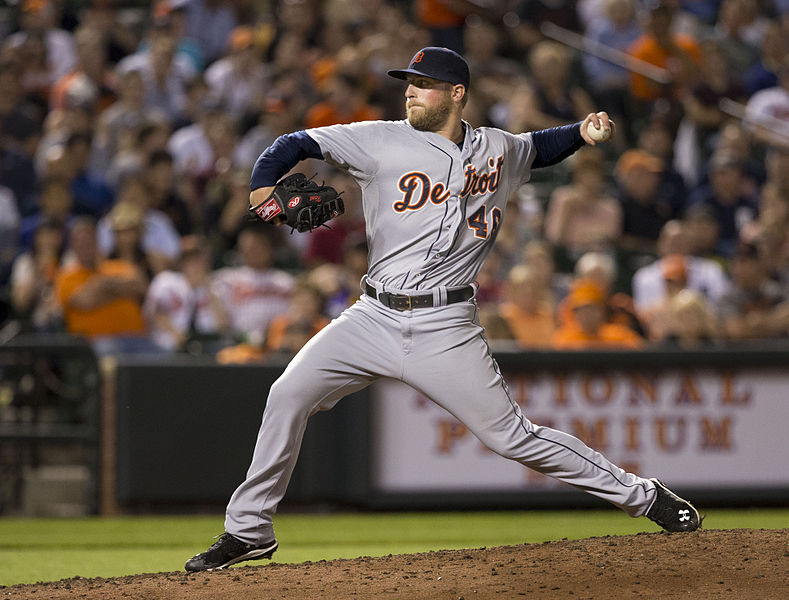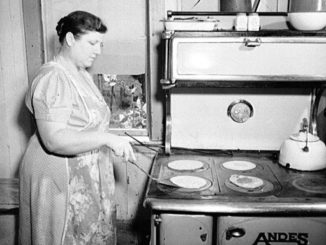Atlanta trades LHP Kevin Chapman and cash considerations to Minnesota for IF/OF Danny Santana. OF Lane Adams optioned to AAA Gwinnett.
Nobody finds the news on off-days quite like John Coppolella, and Monday’s off-day was no different, as Atlanta struck its first trade of the 2017 season, sending AAA lefty reliever Kevin Chapman and cash to the Twins for Danny Santana. Nuts and bolts are why you’re here, so let’s get to ’em.
The Cost
Kevin Chapman was claimed off waivers from Houston during spring training as the Braves sought bullpen depth, particularly from the left side. While he didn’t earn a call-up, he was likely the first southpaw in line at Gwinnett. Despite his ghastly small sample ERA of 7.71, his peripherals looked good (3.68 FIP / 7.71 K9 / 2.31 BB9). Chapman has lived the life of an up-and-down AAAA guy before, reaching the majors for brief stints in each of the last 4 seasons. With a career Deserved Run Average of 5.88 and a -0.8 WARP, it seems likely that’ll be the apex for him going forward. There’s value in that, as Minnesota just showed, but if Chapman is in a MLB bullpen, odds are good that bullpen is beleaguered by injuries.
The Return

Danny Santana burst onto the scene in 2014 and was instantly one of the best players in the American League. At 23, the switch-hitter played only 101 games, but still finished in the top 10 among MLB SS in Fangraphs’ Wins Above Replacement metric. Of the top 17 shortstops in fWAR that year, only Troy Tulowitzki had fewer plate appearances. On a game by game basis, the rookie from Minnesota, batting .319/.353/.472 and 20/24 stealing bases, was one of the best players in the league, and possibly the best SS.
After that magical rookie season, things fell apart:
2015: 277 PA, .215/.241/.291
2016: 248 PA, .240/.279/.326
2017: 26 PA, .200/.231/.360
So, what happened? Was Santana fooling us in ’14 or did something break, something Santana has clearly yet to repair? We look to the peripherals.
For starters, 2014 was blessed by the BABIP gods, as Santana batted .405 on balls in play. He’s pretty fast and doesn’t hit many fly balls, so it’s not outrageously lucky, but you’re just not going to sustain .405, because the 26% line drive rate seemed unsustainable – and it was. In 2015, his line drive rate dropped to 19.9%, and rebounded in 2016 only to 21.6%. He pulled fewer balls and went opposite field more. While my little league coach would have been proud of Santana going oppo, his statline suffered. In 2014, he batted .460 and slugged .802 on pulled balls, which included all 7 of his HR. He did hit .395 with a .500 SLG the other way in 2014, but he was clearly worse when he wasn’t pulling the ball. I don’t know if going oppo more in 2015-16 was a conscious decision, but if it was, it was the wrong one.
After 2014, Santana also had the very concerning trend of swinging at more pitches and making less contact. That’s a toxic trendline, and if Santana is ever going to find MLB success again, he’ll need to reverse it.
Looking at his exit velocity data, two things jump out at me:
- It takes Danny Santana a bit to get rolling. In both 2015 and 2016, Santana came out of the gates averaging an exit velocity in the low-80’s. Once each season progressed, so too did his average exit velocity, topping out around 90 mph.
- Danny Santana hits lefties harder than righties. You wouldn’t tell by looking at his splits, which tend to favor the switch-hitter when he bats from the left side, but the exit velo suggests he hits the ball harder when he’s batting right-handed.
What does this tell us? Unfortunately, not much. There’s not a clear thing Santana is doing wrong, so organizational hitting instructors will have their work cut out for them if he is to get back on track. There are a lot of negatives to his offensive ability right now – if there weren’t, Minnesota wouldn’t have unloaded him for a 29 year old AAAA reliever. That being said, he’s a change of scenery candidate who is gifted physically and only 26 years old. Atlanta didn’t acquire Santana to rely on him; Atlanta acquired Santana just to see if they could be the catalyst to get him back to where he once was.
He’ll have to get his groove back at the plate to be useful, as he was never particularly strong at SS, and the Twins only managed to turn him into a mediocre centerfielder, despite his speed. He can play multiple positions, but he can’t really play any of them all that well.
How does Santana fit into Atlanta? Unless Kevin Seitzer is just the soul mate Santana has been searching for all his life, he will likely be a bench bat at best. You’re not going to like this, but think a younger, more upside-y Emilio Bonifacio. Sorry.




Leave a Reply